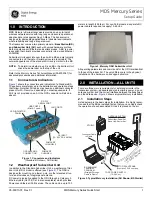
FM Receiver user manual
RF Application Co.,Ltd. All rights reserved. Version 1.0 -Page 7-
Volume control
You can adjust to audio output signal by potentiometer.
TROUBLESHOOTING
General
The usual troubleshooting techniques of checking dc voltages and signal tracing with an
RF voltmeter probe, oscilloscope and spectrum analyzer will work well in troubleshooting the
RFM-1103xK. DC voltage charts and a list of typical audio levels are given to act as a guide to
troubleshooting. Although voltages may vary widely from set to set and under various operating
and measurement conditions, the indications may be helpful when used in a logical
troubleshooting procedure. The most common troubles in all kits are interchanged components,
cold solder joints, and solder splashes. Another common trouble is blown transistors and IC's due
to reverse polarity or power line transients. Remember if you encounter problems during initial
testing that it is easy to install parts in the wrong place. Don't take anything for granted. Double
check everything in the event of trouble.
Current Drain
Power line current drain normally is about 200 mA with volume turned down and up to 300
mA with full audio output. If the current drain is approximately 300 mA with no audio output, check
to see if voltage regulator is hot. If so, and the voltage on the 12V and 5V line is low, there is a
short circuit on the somewhere. If you clear the short circuit, the voltage should rise again
Hum and Noise
The VCO and loop filter are very sensitive to hum and noise pickup from magnetic and
electrical sources. Some designs use a shielded compartment for VCO’s. We assume the whole
board will be installed in a shielded enclosure, so we elected to keep the size small by not using a
separate shield on the VCO. However, this means that you must use care to keep wiring away
from the VCO circuit at the right side of the board. Having the board in a metal enclosure will
shield these sensitive circuits from florescent lights and other strong sources of noise. Because
the frequency of a synthesizer basically results from a free running LC oscillator, the tank circuitis
very sensitive to microphones from mechanical noise coupled to the coil. You should minimize
any sources of vibration that might be coupled to the Receiver, such as motors. Excessive noise
on the dc power supply that operates the Receiver can cause noise to modulate the synthesizer
output. Various regulators and filters in the Receiver are designed to minimize sensitivity to wiring
noise. However, in extreme cases, such as in mobile installations with alternator whine, you may
need to add extra filtering in the power line to prevent the noise from reaching the Receiver.
Other usual practices for mobile installations are recommended, such as connecting the + power
and ground return lines directly to the battery in-stead of using cigarette lighter sockets or dash
board wiring.
Volume control

























